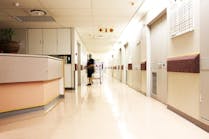Surgical site infections are all too common, even as hospitals try desperately to weed them out and prevent them.
In April, Healthcare Purchasing News reported on a study that suggested that the majority of surgical site infections stem from bacteria acquired before the patient enters the hospital in the first place. This could perhaps explain why their prevalence has not improved much in recent decades – we may be focusing on the wrong places.
HPN had a chance to speak with Dustin Long, M.D., an anesthesiologist and critical-care physician at Harborview Medical Center at the University of Washington and the paper’s lead author, about what he found while performing his research and where clinicians need to focus their energy moving forward to prevent surgical site infections.
Could you tell our readers a little about your background?
I am a critical care anesthesiologist at Harborview Medical Center. So clinically, I spend my time performing anesthesia in the OR mostly for traumas and burns, as well as working in our trauma surgical intensive care unit. At the University of Washington, I perform research on healthcare associated infection with an emphasis on surgical site infection and antibiotic resistant bacteria.
How would you characterize conventional wisdom about surgical site infections?
I would say that there is a disconnect between the guidelines and clinical practice and commercial product development. What we see in day-to-day operations and, to some extent, the commercial product development pipelines related to surgical site infection, is heavily focused on environmental sources of infection within the hospital. That’s not to say that those aren’t important, but the science has shown that the vast majority of surgical site infections, at least those caused by the bacterium Staphylococcus aureus, come from the patient, not from the hospital environment. The science and the associated medical guidelines really emphasize measures that are focused on the patient. What our study adds is broadening the scope of that association beyond Staphylococcus aureus by using some new genomic methods.
Was there an inciting event that led you to undertake this study?
The main thing I would point out is that the authorship team that led this study is a team of physician scientists. We are surgeons, anesthesiologists, and infectious disease physicians who take care of these patients on a regular basis. We do this because we want to provide high quality care, and it’s very dissatisfying to us and to patients following all of the best practices to have a significant number of infections, and when this happens, there’s typically no explanation as to why this occurred in this particular patient. We really just wanted to understand this in more depth so that we could have a sense of what was not working and what we might be able to do better.
Can you expand on what is meant by patient-centered models for infection prevention?
If you were standing in an OR today, there is a lot of emphasis and a lot of eyes on things like door openings and closings, ultraviolet light for surface decontamination, hospital garb, caps and masks, surgical attire, these types of things. A lot of the hospital’s energy is focused on these environmental sources, and yet we know from the science, with modern antiseptic practices and modern environmental hygiene in a hospital, that that’s not where most of the residual infections are coming from. They’re coming from patient flora that are not effectively being addressed by our antiseptics, our surgical antibiotic prophylaxis, and our preoperative decolonization regimens.
Instead of putting all our focus on our own hospital, we really want to shift that focus of infection prevention to the patient and ask ourselves if we are tailoring our interventions to that patient. We know that most of these infections are resistant to the antibiotic prophylaxis that we give, so how can we personalize that for the patient? We know that our approach to preoperative decolonization is imperfect, so how can we make that more effective and more consistent in terms of how we’re doing preoperative bathing and nasal decolonization?
This is not to say that we want to take our foot off the gas pedal in terms of keeping the hospital clean. Instead, we want to put the focus on the individual level of figuring out how we can better control the patient microbiome coming into this vulnerable state of surgery.
Is there anything individuals can do to prepare before they undergo a surgery to prevent this from being as big of a risk?
There’s still a lot of research that needs to be done to inform more effective prevention measures. With what we know today, if I was a patient coming into surgery, I would want to take very seriously the recommendations given for preoperative bathing with Chlorhexidine for skincare and for adhering to the protocols of nasal decolonization. You want to reduce that bioburden of bacteria on your skin as much as possible. There’s no way to completely sterilize skin tissue, even with antibiotics and antiseptics that we use in the OR, but knocking down that bioburden starting days or weeks before surgery is likely to be beneficial.
Is there anything clinicians or surgeons can do to inform the patient of these risks, or to minimize infections carried by the patient prior to surgery?
In the short term, there is still room to practice standardization around best practices in terms of things like screening patients for organisms such as MRSA before surgery and then providing targeted prophylaxis for those patients. Other things like control of perioperative blood sugars for patients with diabetes and intraoperative temperature management – these things can be improved throughout healthcare systems broadly. People try really hard, but we’re kind of hitting the point of diminishing returns in terms of how much more adhering to these established guidelines is going to get us closer toward zero.
I think what we really need is new approaches and new technologies that are very different than what we’re doing now. These would be things like preoperative screening of the microbiome to identify patients with strains that are resistant to our standard surgical prophylaxis and then tailoring that so the antibiotic matches the patient instead of just providing the same antibiotic to every patient which we know is not effective. We have sequencing based tools for measuring that now, and we just need to apply those. If we’re not effectively providing deep decontamination of the skin before starting a surgery, what other tools than antibiotics can we use to eliminate those bacteria from the skin? Focusing our thinking more on those patient sources to develop new protocols could be beneficial.
What can be improved upon in the short term?
We’re really focusing on low-tech stuff. We’re reassessing how we do simple things like daily bathing for our inpatients who are awaiting surgery. We are completely restructuring and overhauling our preoperative MRSA screening program and changing our approach to nasal decolonization for patients. We’re simply going back to the basics.
How can patients be protected from themselves prior to surgery?
What we know is that there are bacteria that colonize our bodies and, in normal states of health, they usually don’t cause any problem. But once a medical procedure is performed, like a surgery or inserting a urinary catheter or a tracheal tube, that disrupts these normal protective anatomic barriers that keep those bacteria in their place. The vulnerability of major illness or surgery allows those bacteria an opportunity to make this switch from being colonizers to kicking in as pathogens and signaling to each other that there’s an opportunity to mount an infection.
There’s a lot of work exploring what we call “anti-virulence therapeutics” so that we don’t have to kill the bacteria – we merely have to keep them in check. We can change the way they signal to each other so that they stay more as these indolent colonizers and don’t try to mount an infection when the host is susceptible.
What do you think should be looked at next given the results of the study?
One of the immediate next things that we would like to do is do this type of research in other surgical populations and procedural groups. Longer term, we’re very interested in tailored approaches to infection prevention. We’re starting to develop some of the tests and molecular techniques needed to test a patient before surgery and get a result rapidly so we could use that information just a couple of days later at the bedside.
How can we get that “one in 30” number for surgical site infections down?
Changing the way that we talk about the issue of surgical site infections is important. There is a culture of shame around surgical site infection that leads to there not being good quality transparent data sharing. I think that has really hammered the advancement of patient care in this area. We hope that doing research like this moves this beyond the culture of shame and helps us understand what we are doing that is effective and ineffective and how we can fill ni some of those gaps.
Until we start looking at this as a more scientific issue and start sharing data and investing in basic research, I think, if anything, we’re going to see that one in 30 number heading in the wrong direction.

Matt MacKenzie | Associate Editor
Matt is Associate Editor for Healthcare Purchasing News.





